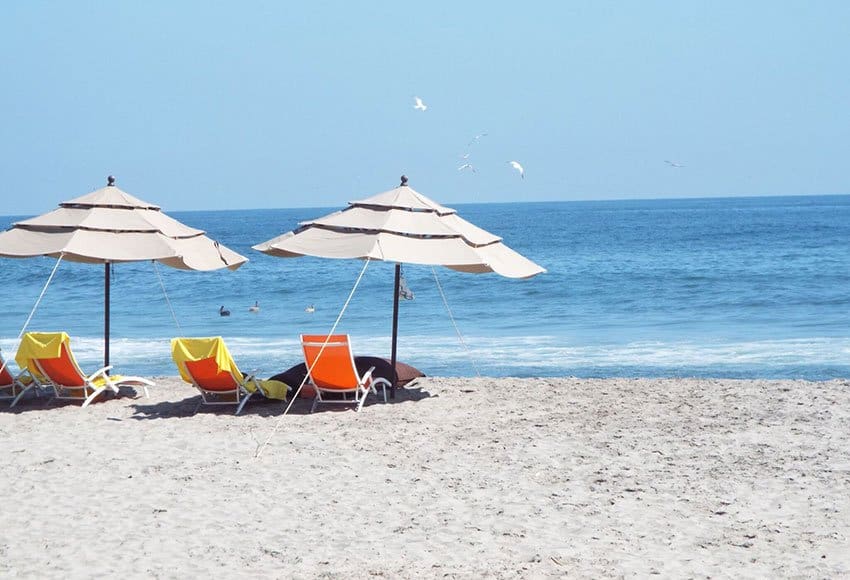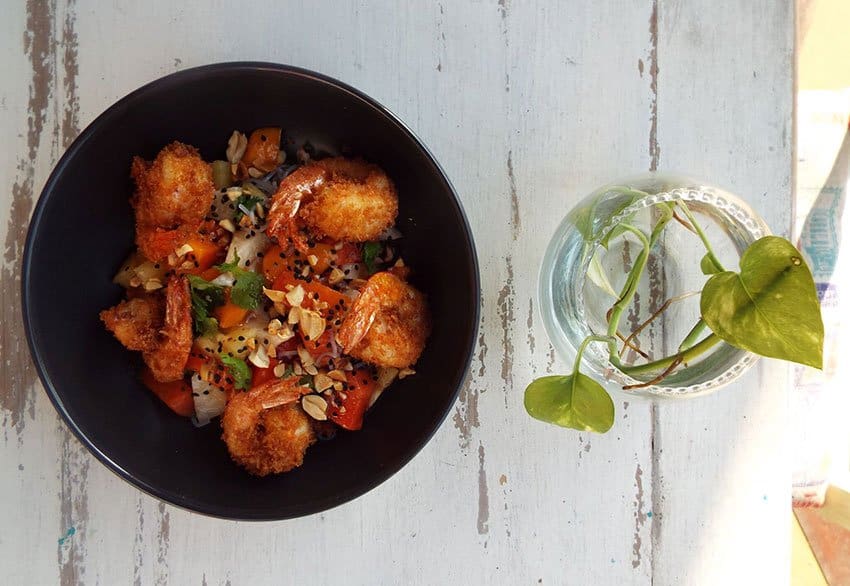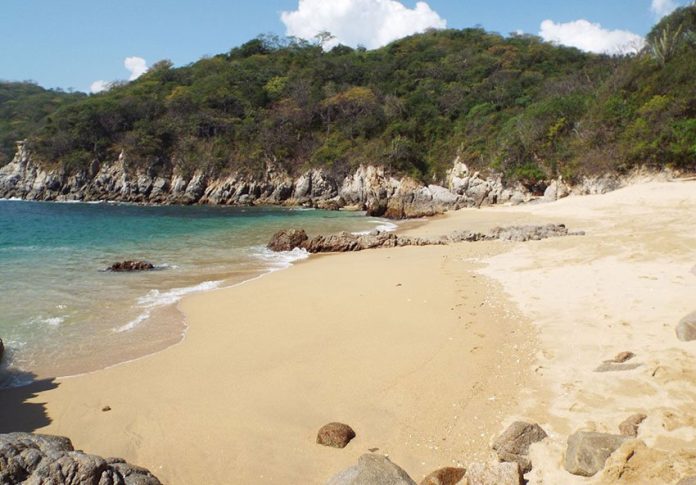“That’s the entrance,” said my taxi driver, pointing at a cement drainage ditch that sloped downward into the sub-tropical jungle.
“That’s the entrance?” I asked and he nodded and started his engine.
Carefully, in my flipflops, beach bag slung around my shoulder, I stepped sideways down the steep trail that came after the drainage ditch, down to the sea. I came out from the cover of trees on to the tiny El Violin beach. A head bobbed a few meters out past the shore, snorkeling over the reef, a family of three sat on the other side of the rock line that divided the beach in half.
Beside them there was nothing but sun, sand, rocks and the occasional passing boat. Ducking my head under the water I could hear the crackling sound made by the reef nearby, and fall leaves, beaten baby-soft by the tide, floated around me.
This was just one of the virgin beaches I explored last month in Huatulco on Mexico’s Oaxaca coast. Huatulco is a series of bays, beaches and small towns that make up a region developed into a tourist destination in the mid-1980s.

It was not on my radar until I was invited to come down and see this little slice of paradise for myself, and I was hesitant about what I would find. Searching online for information I wanted — the best places to eat, the most isolated beaches, the coolest tours — was an exercise in futility. Now that I am back I can say that Huatulco is delightful, with lots to offer if you know where to look.
Eating
I really don’t want to travel anywhere where I can’t get good food, so getting some local restaurant recommendations was my top priority upon arrival. Mexican beach destinations are notorious for strings of identical oceanfront restaurants that are pretty mediocre and/or gourmet spots that cost an arm and a leg, and still pretty mediocre.
In Huatulco I found some reasonably priced places where the food was excellent — but it did take getting off the beach.
My first stop was at El Chino, opened just a few months ago in the town of Santa Cruz. Like every place on this list El Chino is not on the beach, but the vibe is as beachy as it gets — hammocks strung from poles that frame an open-air restaurant, a palapa roof. If I could recommend two things on the menu, I beg you to try the chile de agua stuffed with marlin and the chilpachole (soup might sound too hot for 30 C weather, but just trust me).
For more light beachy fare, try La Tosta in the town of La Crucecita, a few blocks off the main plaza. They have a mixed seafood tostada (a crispy tortilla) and an octopus ceviche tostada that I am still dreaming about.
Rocoto is evening dining on Benito Juárez boulevard and is run by a Chilean-Mexican couple that have a killer coconut shrimp soup and an octopus and mushroom quinoa dish that I couldn’t even comprehend (in a good way).

These women are serving up different specials every night centered around local seafood and ingredients. Rocoto needs to be on your list for at least one night of your vacation, but they are often packed so make a reservation or come knowing you may have to wait.
Mercader in Santa Cruz has an Asian-Mexican fusion menu, with dishes like Vietnamese rolls, a tamarind shrimp salad with tropical fruit and rice noodles, or salmon croquettes with chipotle sauce.
My last suggestion is local classic El Chacal, named after the river lobster native to Huatulco. They serve some special preparations of the little creatures there, but my favorite was grilled with butter and garlic. Also great was the fish ceviche with tomato and cucumber.
This is a homestyle place with sandy floors and a thatched roof. It sits right next to the Copalito river and any local can give you directions. A few other suggestions I got? Juanita’s Cafe on fish taco night; Cafe Viena, an Italian joint run by Italian immigrants, Che Dieguito, an Argentinian steakhouse; and Las Tlayudas de Sector E for local Oaxacan fare.
Beaches
With 36 local beaches, you can visit a different one every day for your entire vacation, which was pretty much my plan. El Violin, described above, is great for solitude and snorkeling. Cacaluta is a gorgeous beach where I can almost guarantee you’ll be alone, because it requires a short hike through Huatulco’s National Park and so isn’t very frequented by the everyday tourists.
The hike is about a 20-minute leisurely walk and can get a little swampy in places. Along the way you pass a beautiful bird estuary and you’ll see dozens of butterflies in your path. Don’t stress out if the path isn’t clearly marked, just keep heading towards the ocean. Waves here were a little stronger than some of the more mellow bays.
El Tejon (often called El Tejoncito) is more centrally located near Chahué bay, but it also takes a small walk to get to it. A cab will drop you off at the entrance to a residential development and you have to walk in and to the left along a paved road. The entrance is an unmarked trail downward right next to a black trash bin. This is another virgin beach made for peace and quiet.
If you don’t mind other tourists the Santa Cruz bay has some of the calmest waters for swimming and there are other beaches in the bay you can reach via boat or car like La Entrega or El Órgano. Arrocito is a tiny beach to the south of Chahué marina with a beach bar with tables, umbrellas and cold beers. Tourist traffic can be heavy, but again, the waters are extremely calm for swimming.
La Bocana is a favorite of foreigners and is known for its good surf. This beach is more open ocean than the bays and so the waves are bigger and the beach stretches down further.
There are several other beaches accessible from inside the national park. They are unmarked and unnamed and so pretty isolated, but a local taxi driver can point out a few for you. My big regret was not making it to Riscallillo which is only accessible by boat but is said to be lovely. It’s also inside the national park, north of Cacaluta.
Activities
My hosts for the week, Aventura Mundo, have a bevy of local tours and adventures that they arrange for visitors including a breathtaking moonlight cruise down the Copalito river and a night kayak tour to see the local phosphorescent plankton.
For early risers, local guide Shiro Lopez (961 370 0744) offers a sunrise fishing and snorkeling tour. We went out at 5:00 one morning and were honored with a spectacular dawn and a few fish for breakfast.
Definitely catch a bird-watching tour to one of the local nature reserves (try Cornelio Ramos, 958 106 5749) and snorkel the reef, either on your own in one of the small bays or with a group. For a beach break, Aventura Mundo arranges glamping excursions to Pluma, Hidalgo, a nearby coffee-producing region about an hour and a half into the Oaxaca mountains.
General Tips
Almost everywhere you go in Huatulco by cab will cost you around 40 pesos (US $2.50) unless you are headed to one of the beaches farther from town. Santa Cruz and La Crucecita are like little towns, places like Arrocito and Chahué more like residential areas. Tangolunda bay and Conejos bay are home to the major resorts as well as some vacation rentals, mostly condos.
Having your own car is definitely the easiest way to get around, but cabs will also take you anywhere and there is a local bus that runs up and down the main boulevard.
Lastly, come to Huatulco in search of surf, turf and relaxation — this is not a place for dance clubs, high-end shopping, and lots of entertainment. It’s more a place to enjoy the sun on your face and a cold beer in your hand.
Lydia Carey is a freelance writer based in Mexico City.
